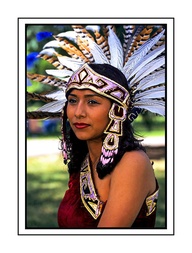
In the age of contemporary fashion and beauty, many who once carried a traditional idea of beauty, now question the very roots of what beauty means. Indigenous Latin Americans are tightly bound between a Euro centric world and their own Mestizo surroundings. While countries throughout Latin America, accept a Mestizo identity and ignore ‘racial differences’, others who do not fit in this identity are forced to find connections elsewhere.
Anthropologists have been and are still determining what beauty should be amongst ethnic people. When it concerns Indigenous Latin Americans, analysis of skulls, nose shapes, and the like have determined that Indigenous Latin Americans could use the same tactics as their predominantly European Spanish speaking counterparts. What would those tactics be? Anthropologists felt that it was more than justified for Indigenous women to narrow their noses, round their eyes, and straighten their hair. They had the ‘ ability’ to carry a different more contemporary look. Unfortunately through media and the environment, Anthropologists’ theories have prevailed and the traditional beauty Indigenous women once recognized is being lost.
While there are thousands of different tribal ethnicities throughout Latin America, many shared a common idea of beauty. In Mayan cultures, traditional beauty is seen through unisex beaded jewelry, filing the teeth into designs, cross eyes, body tattoos, hair layering to make it look thicker, and tightening clothes to give the effect of fuller waists and bottoms. Modern day Mayans may often choose a more ‘Latina look’. This means they would prefer to look thinner, with a thin narrow nose and straight hair. Tattoos for some now is related to a wild or unfeminine Latina. Thicker clothing is now out of the question as more contemporary Western fashion becomes ideal. And this is not unique to modern Mayan cultures. In fact throughout Central America and Mexico, Indigenous females prefer to be tall and skinny. Some even lighten their hair and eyes. Round faces are frowned upon as they relate to ‘ an ethnic look’ and body bleaching is prevalent within Indigenous communities. Dark skin is related to crime, hyper sexuality, and lewd women, especially in Colombian, Venezuelan, and Brazilian media. Indigenous women in these countries attempt to differentiate themselves sometimes through body bleaching, lense coloring, and hair straightening. In Peru and Ecuador wider foreheads, beaded jewelry, and curly layered hair was very common for several Indigenous tribal women. However, that too has become lost in what is now referred to as the ‘Latina look’. Indigenous women have adopted a Eurocentric look, however they have not forgotten their Indigenous traditions.
While Indigenous standards of beauty are no longer common in their communities, they are not completely lost. In fact contemporary Indigenesmo movements, particularly in Mexico and Brazil, have reintroduced Indigenous standards of beauty. Marches and celebrations have opened Indigenous culture and traditions to Latin American countries and the world. While there has been much resistance to such Indigenous movements, nonetheless they have thrived and rekindled the Indigenous cultural flame. Many women, like the woman in the picture, have used these celebrations to adopt Indigenous looks. She, like many women, no longer have all of the Indigenous standards of beauty, but she has used this time to wear jewelry and clothing representative to her Indigenous ethnic roots. This has brought hope to many that Indigenous culture is not completely lost and will once again thrive as it had so long ago.
Beauty may have changed its face in Latin America, but the beauty found in traditional Indigenous women have not been forgotten.
Askira







